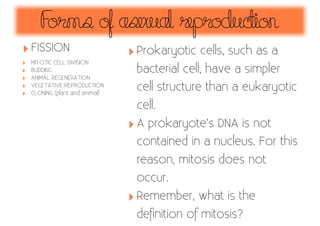Asexual reproduction allows organisms to reproduce without meiosis and fertilization, resulting in offspring that are genetically identical to the parent. It occurs through various methods like fission, budding, regeneration, vegetative reproduction, and cloning. Fission involves a prokaryotic cell splitting into two identical daughter cells. Budding occurs when an outgrowth from the parent develops into a new individual. Regeneration involves regrowing a new individual from a fragment of the parent. Vegetative reproduction is seen in plants that produce new individuals from stems, leaves, or other vegetative plant structures. Cloning produces genetically identical copies in a laboratory setting. Asexual reproduction allows for rapid population growth without locating a mate. [/SUMMARY]











































